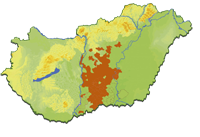 The Kunság Wine Region has eight districts and a total of 96 towns and villages. The size of a district is equal to the average size of other Hungarian wine regions’ wine-growing areas. The region is composed of 68 wine-growing communities with 32 800 members. It produces about 200 000 tons of grapes yearly.
The Kunság Wine Region has eight districts and a total of 96 towns and villages. The size of a district is equal to the average size of other Hungarian wine regions’ wine-growing areas. The region is composed of 68 wine-growing communities with 32 800 members. It produces about 200 000 tons of grapes yearly.
64 different grape varieties are grown in the region, of which 10 typical varieties take up two-thirds of the total vine-growing area. These common grapes of the Kunság Wine Region are Arany Sárfehér, Zala Gyöngye, Ezerjó, Blaufränkisch, Cserszegi Fűszeres, Müller-Thurgau, Kövidinka, Kadarka, Kunleány, and Italian Reisling. The white wines produced here have a harmonious composition and light character. The regions’s red wines are the ruby-red, spicy smelling, and luscious Kadarka, and the light and yet spicy Blaufränkisch.
An increasing number of the Kunság Wine Regions’s wine producers make fresh, fruity, and palateful quality wines, of which some rosés belong with the best in the country.
